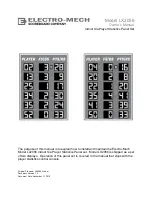
19
Environmental requirements
Flame retardants
Flame retardants are present in printed circuit boards, cables, wires, casings and housings. Their purpose is to
prevent, or at least to delay the spread of fire. Up to 30% of the plastic in a computer casing can consist of flame
retardant substances. Most flame retardants contain bromine or chlorine, and those flame retardants are
chemically related to PCBs. Both the flame retardants containing bromine or chlorine and the PCBs are suspected
of giving rise to health effects, including reproductive damage in fish-eating birds and mammals, due to the bio-
accumulative* processes when not disposed of in accordance with strict standards for disposal.
The relevant TCO’99 demand requires that plastic components weighing more than 25 grams must not contain
flame retardants with organically bound bromine or chlorine. Flame retardants are allowed in the printed circuit
boards since no substitutes are available.
Cadmium**
Cadmium is present in rechargeable batteries and in the colour-generating layers of certain computer displays. The
relevant TCO’99 requirement states that batteries, the colour-generating layers of display screens and the electrical
or electronics components must not contain any cadmium.
Mercury**
Mercury is sometimes found in batteries, relays and switches. The relevant TCO’99 requirement states that
batteries may not contain any mercury. It also demands that mercury is not present in any of the electrical or
electronics components associated with the labeled unit. There is however one exception. Mercury is, for the time
being, permitted in the back light system of flat panel monitors as there today is no commercially available
alternative. TCO aims on removing this exception when a mercury free alternative is available.
CFCs (freons)
The relevant TCO’99 requirement states that neither CFCs nor HCFCs may be used during the manufacture and
assembly of the product or in its packaging. CFCs (freons) are sometimes used for washing printed circuit boards.
CFCs break down ozone and thereby damage the ozone layer in the stratosphere, causing increased reception on
earth of ultraviolet light. This restriction assures that further damage to the ozone layer form this type of equipment
will be eliminated.
Lead**
Lead can be found in picture tubes, display screens, solders and capacitors. The relevant TCO’99 requirement
permits the inclusion of lead since no replacement has yet been developed.
_____________________________
* Bio-accumulative is defined as substances which accumulate within living organisms.
**Lead, Cadmium and Mercury are heavy metals which are bio-accumulative.
Summary of Contents for VISIONARY LCD 19-1
Page 1: ......
Page 2: ...19 LCD Display TARGA VISIONARY LCD 19 1 User Guide...

































